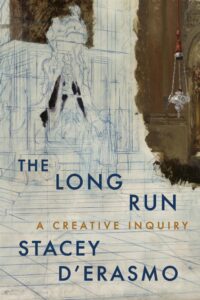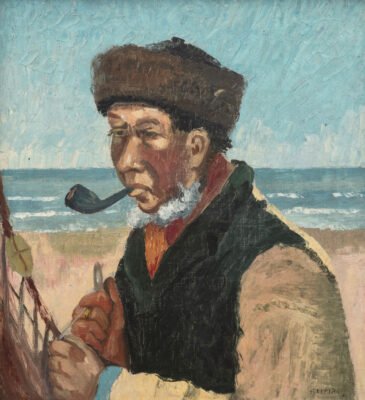How do we keep doing this—making art? My question can be read in two ways: What keeps us alive in our art; on what do we draw, year after year and project after project, to keep doing this? And, what happens to us as we keep doing this? In what manner do we keep doing this? This is the question that inspired my book The Long Run: A Creative Inquiry.
Article continues below
When I began asking this question in an essay that I published in The Rumpus in 2010, I had never felt more alive in my own vocation. I was working on two projects that were dear to my heart and all I wanted was more time and space to finish them. I had an official community in my teaching life, and a thick community in my personal life that was fundamental to my work. So when I asked back then, How do we keep doing this? my interest was keen, but a little academic. I wanted, more or less, a map of the road ahead that would show me what to expect and what to do. My friend the writer Andrew Altschul and I thought that a good book could be made from my essay by soliciting essays on the long run from various writers and artists who were older than we were. We lined up some great folks, and started shopping the anthology around.
What do the desire paths look like of writers and artists who have done this over a lifetime?
Then things changed. For different reasons, first my personal community and then my official community fell apart. I did finish the two projects and launch them into the world, but while they were well-received, they didn’t live up to the expectations with which they were published. For about five years—beginning in 2010, funnily enough—things kept breaking. Relationships broke, friendships broke, promises broke. Where I lived, who I lived with, who I counted on, who counted on me, and where I worked all changed, sometimes quickly and vertiginously. Many facets of my identity shattered. About four years after I published that essay, I found that, while words might flow initially, I couldn’t sustain a project. After twenty pages or so, I would lose interest and momentum. The words seemed weightless, rootless, tinny. I kept trying and I kept failing.
It was extraordinarily painful and bewildering. For as long as I had been writing seriously, more than twenty years by then, I could always find the well no matter what else was happening in my life or in the world. I wrote with and without money, during times of family upheaval, throughout breakups, on the road, in dilapidated barns, in splendid rooms of my own, and on Post-its while riding the subway. When my therapist of many years died unexpectedly, I wrote. When a close family member went missing, I wrote. When I left a lover, I wrote. When a lover left me, I wrote. When I had a deadline for a book, I wrote, and when I had no book contract and no idea if I could get one, I wrote. When my publisher seemed to be going out of business and editor after editor left, I wrote. There might be obstacles to the well, minefields and bears, but those obstacles weren’t generated by me. Now, however, I was lost. I still don’t know how articulate I can be about why this particular confluence of events was my Kryptonite. Call it a loss of faith. Perhaps I was simply overdue.
No one wanted the anthology, although Graywolf did want a nonfiction book by me extending my essay. I signed a contract, hoping. After all, I could always just give the money back. I didn’t write the book for years, until, one day, I knew that I wanted to write the book somehow, if I could, if Graywolf still wanted it. They did.
I compiled long lists of writers and artists to interview. I knew that my question—what has sustained you over the long run?—was unanswerable, but I figured that the consideration of that unanswerable question would yield complexity and nuance and the visceral texture of life: the aged dancer’s foot, marked and deformed and sculpted by decades of chosen use. But as I was interviewing the artists whose long runs I admired, I found that I didn’t want to write straightforward profiles of them. In one way, it all felt a bit invasive, and also frustrating: the profound connections between the life and the work often can’t be articulated, and/or, people aren’t going to tell you what they are, no matter how clever you are at trying to get it out of them. One woman, who took breathtaking risks to make breathtaking art, dismissed my interview request altogether, saying, “I don’t give out details of my personal life, as it has little do with my work.” To which I thought, Oh, come on.
How was it my business, anyway? Why should these amazing older artists, or anyone, bare their souls to me? At the same time, I found that I was becoming drawn by an equally quasi-impossible desire to articulate how my own sensibility has developed over time—my own long run. I discovered that I had grown older not being able to write the book I had first intended to write. I wasn’t as old as the amazing older artists, but I was old enough. I wanted to say how it was for the queer writer and woman I was becoming when I was young, and how that has changed over time. I wanted to get at something, a sort of personal zeitgeist, that will go away when my generation goes away.
I have always found it sustaining to turn to someone else and say, “This is how it is for me. How is it for you?”
I began again, with a deeper sense of urgency and consequence. Now I knew what it was like to sustain a vocation over decades. Now I knew, viscerally, that losing one’s sense of vocation is like being in hell. My curiosity had become bloodier and more insistent: How do we keep doing this? What happens over a lifetime of doing this? In urban planning, the habitual paths taken by people on foot or on bicycle rather than the paved roads which either don’t exist or are too linear and awkward are called “desire paths.” What do the desire paths look like of writers and artists who have done this over a lifetime?
I realized that in my own long run, one of the main things I have always reached for to sustain me is company. The company of lovers. The company of friends. The company of other writers and artists, living and dead. With the book, I created a circle of elders, my own chosen ancestors in this vocation. They did not, of course, ask to be this for me, or for anyone. They simply lived their lives. This book is a love letter, but it is also a demand. Maybe all love letters are demands. In any case, what seems clear to me is that I have always found it sustaining to turn to someone else and say, “This is how it is for me. How is it for you?”
I felt that I would have better conversations with people I didn’t know too well, or at all, that my approach to them would be more open that way. Often the people I found who were willing to talk to me at length about such a personal and impossible question, were friends of friends, people who had been neighbors, people who had worked with people I knew. Via this informal network of a few or more degrees of separation, I found the visual artist Cecilia Vicuña, the dancer Valda Setterfield, the landscape designer Darrel Morrison, the writer Samuel R. Delany, the actress Blair Brown, the painter Amy Sillman, and the musician Steve Earle. Feeling certain that no one would write me back, I cold-contacted the Pulitzer Prize-winning composer Tania León through her website, and, amazingly, she agreed to be interviewed several times. I included scenes from my own life where and when they seemed relevant; the book began to include a fugitive, occasional memoir—a form that was new to me, and slightly terrifying. I wrote the book.
The Long Run itself, of course, is a desire path. It is subjective, partial, incomplete. It is not definitive. It is not an instruction manual. It is not canonical. It is a collection of glimpses, of questions, of conversations in reality and in the imagination. It’s how far I’ve gotten.
__________________________________

From The Long Run: A Creative Inquiry by Stacey D’Erasmo. Copyright © 2024. Available from Graywolf Press.






